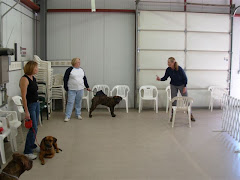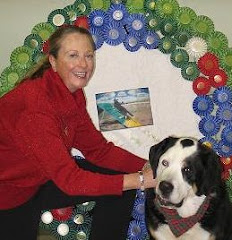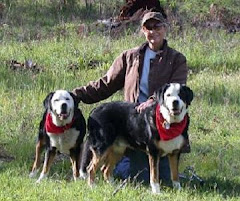Hi Jan,
We have two young German Shepherds who are real sweethearts most of the time. But they also get into considerable trouble--jumping on people (but not my husband), not listening to my commands (although they listen pretty well to his), and pulling me on the leash (although not as badly when he's walking them). Husband says they don't see me as a pack leader, and that I need to be tougher with them. I really do try. I try to make my voice sound loud and deep when I'm angry. I want them to love me and not be afraid of me, so I'm very kind to them the rest of the time. What can I do to make them see me as the one "in charge," especially since my husband is gone a lot as a long-haul trucker.
Sherry
Hi Sherry,
It sounds like your dogs probably see you as two personalities: the kind, sweet-natured, gentle person when they're good, and the gruff, strong meanie when they're "bad." In our culture, someone with two personalities is known as schizophrenic or bipolar. Those are mental disorders. Now, of course you're not bipolar, but YOUR DOGS SEE YOU AS SOMEONE WITH A MENTAL DISORDER! Because of this, nothing you say or do to them carries much weight.
We as humans tend to be emotionally reactive. Dogs, not so much so. Emotional swings are viewed as mental instabilities in nature. And mentally unstable individuals don't make good leaders.
Instead of trying to make your voice "loud and deep" when they are "bad," and high and sweet when they are good, strive for an even tone at all times. Remember that most "conversations" among dogs in a pack are nonverbal. It's more about body language. While your voice is certainly an effective communication tool, your actions speak louder and your voice just reinforces what your actions have said.
Whatever your dogs' ages, try speaking to them as you would to your teenage children. In other words, use an authoritative but respectful tone of voice...one that treats them as the adults they'd like to think they are! Depending on your dogs' personalities, you may even be able to nearly whisper your requests to them. Just be sure to back up your requests with the appropriate body language. Never use anger or threats.
The body language of a strong leader includes good posture, a calm demeanor that says you're in control, firm pets and pats, strong eye contact on your terms, and an air about you that says "I'm in charge." These are signals your husband sends to the dogs, even though he's not around them as much as you are.
Remember that strength can be shown any number of very positive ways. Mother Theresa was just as strong a leader as General George Patton. But two traits they both possessed in their leadership styles were CONVICTION and CONSISTENCY. Conviction is knowing precisely what you want and what you stand for, and being prepared to get it. Consistency is doing things the same way, or being the same person, all the time. Show your dogs your conviction and consistency and they will respond just as well to you as they do to your husband.
Questions about dog behavior and training? Send them to: sandersagility@gmail.com.
Monday, April 14, 2008
Subscribe to:
Post Comments (Atom)


















No comments:
Post a Comment